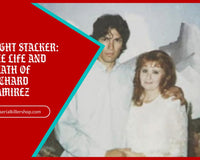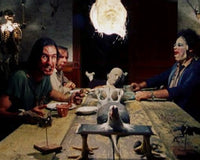In times of sickness, we put our lives in the hands of doctors, nurses and other medical staff. There is an unspoken trust between doctor and patient, a trust we assume is there due to the nature of their profession.
But what if these people aren’t who they claim to be? What if they’re hiding a dark side?
Indeed, there have been numerous cases of doctors taking the lives of their patients, but in the case of Harold Shipman, a doctor from Manchester, England, his victim count far surpassed anyone who came before him, making him the most prolific serial killer in modern history.
Here’s everything you need to know about Doctor Death, Harold Shipman.
Shipman's Traumatic Childhood
Harold Frederick Shipman, born in 1946 in Nottingham, England, had a troubled childhood. His mother, Vera, was overbearing and dominant and dictated everything about her son’s life.
Although Shipman was highly intelligent as a youngster, he suffered socially, struggling to make friends right through until the end of high school. He achieved good grades and became an accomplished athlete during his school years, but his social circle was sorely lacking. The only friends he truly had was his mother and sister.
Despite her domineering personality, Shipman idolized his mother. She was the one who told him he was better than others and destined for great things once his school days were over.
His Mother Died The Same Way He Killed His Victims
When Shipman was a teenager, his mother was diagnosed with terminal lung cancer.
Each day after school, Shipman would return home to sit at his mother’s side and talk to her to ease her emotional pain. Vera’s physical pain relief, however, would only come when the family doctor administered high doses of morphine into her system.

Shipman watched in fascination as his mother slipped from agony into a state of bliss, grimly echoing the acts Shipman later carried out on a mass scale.
Shipman’s mother eventually passed away on 21st June 1963, leaving her son alone and heartbroken.
Shipman Becomes A Husband And Father
At age 19, Shipman began studying medicine at Leeds University. Around this time he met his future wife, Primrose May Oxtoby. Primrose was the only woman Shipman was ever with throughout his whole life. They married in 1966 and went on to have four children together.
Primrose stayed by Shipman’s side, even after the damning evidence of his guilt was discovered. She maintained that her husband was an innocent man.
Early Signs Of A Killer
In 1974, Shipman began working as a doctor and gained a reputation as a respected community doctor.
But only a year later, he was caught forging prescriptions of pethidine, a painkiller similar to morphine, for his own use. He was fired from his position and sent to a drug rehabilitation center.
*Quick note: Did you know we have a huge true crime merch store? We even have a Harold Shipman T-Shirt. Your support keeps our site ad-free!*
Despite the lasting effects of this forgery on his record, Shipman was back working as a doctor two years later in Hyde, Manchester. How quickly he was able to do this, given that he was now widely-known as a fraudulent professional, is evidence of his ability to manipulate others into believing his innocence.
It wasn’t long before he was back to being the respected community doctor he once was.
Two Decades Of Murder
For the next 23 years, Harold Shipman carried out a killing spree the likes of which are unparalleled in the annals of true crime, amassing somewhere in the region of 250 victims. A number similar to prolific serial killer Albert Fish.
By night, he was a loving and devoted husband who raised four perfect children. But by day, he was a cruel and scheming killer, hiding his murderous desires behind the guise of the friendly neighborhood doctor.
In 1998, a local undertaker named Alan Massey noticed that Shipman’s patients were dying at an alarming rate. Massey was the person responsible for transporting the bodies of Shipman’s victims from their homes, and quite often, he noticed things that didn’t add up. Many of the patients were healthy and suffered no severe illnesses, so he couldn’t understand why Shipman supplied them with such massive amounts of morphine.
Massey confronted Shipman about it, but Shipman showed Massey each patient’s certificate book which prescribed them morphine. However, these records weren’t authentic.
Harold Shipman Gets Too Confident
The death of Kathleen Grundy on June 24th 1998 would be the turning point for Shipman.
Kathleen was discovered dead on her sofa by friends, and it came to light that Shipman had been with her only hours before she passed away. Shipman’s excuse for being with Kathleen was he was taking blood samples for medical research. He also told Kathleen’s daughter, Angela Woodruff, that an autopsy wasn’t required to determine how she died.

But even more bizarrely, Angela’s solicitor later informed her that Kathleen had recently submitted her last will and testament, and in the will, Kathleen had left the considerable sum of £386,000 to Doctor Shipman.
Angela became suspicious. Why would her mother leave such a large amount of money to a doctor she barely knew and hardly visited?
Angela located the written document itself and found many errors. It was badly-typed and the signature didn’t match her mother’s. Angela informed the police of what she’d found.
Police Dig Up His Past
Police investigated Shipman under the belief he was forging documents, but what they discovered was much more horrifying.
Shipman’s home and office were searched and police found pieces of women’s jewelry, discarded medical records and most importantly, a typewriter that matched the typeface and layout of the Kathleen Grundy’s alleged will and testament.
After speaking to the families of the recently deceased patients under Shipman’s care, it came to light that Shipman had ‘advised’ the families to cremate the bodies of their loved ones and to not request any further investigation regarding their deaths. But even if a family member did request further details, Shipman had already falsified all of his patients’ medical records to justify the doses of morphine he injected into them.
Mistakes Were Made
Despite Shipman’s grandiose sense of superiority, one area he was not covertly skilled in was with computers.
Although he claimed he was a “computer expert”, it would be his falsifying of documents which would lead to the discovery of his previous victims. Shipman was unaware that every change he made to his patients’ medical history was logged on his hard drive with specific details and time stamps.
Damning evidence was discovered that revealed Shipman had killed at least fifteen of his patients by injecting them with fatal levels of morphine. The police confronted him with this information but Shipman refused to co-operate and simply denied all claims.
It Goes Way, Way Back
No one could believe that the mild-mannered local doctor had so cruelly taken the lives of fifteen people who trusted him. Just this figure alone is enough to make Shipman one of the worst serial killers in British history, but after further investigation, it was discovered that Shipman’s murders went right back to 1975.
Between the years of 1971 and 1998, a total of 459 patients had died under Shipman’s care. Accounting for natural deaths, this was an additional 250 deaths when compared to other doctors. The numbers were abnormally high dating back to his very first year working as a doctor.
Interview Footage Shows Shipman's Guilt
During police interrogation, Shipman closed his eyes and remained silent, refusing to look at pictures of his victims or speak to any officers.
However, in this chilling interview footage, Shipman can be seen holding his breath when the name of one of his victims is mentioned.
The officer presents a picture of Elizabeth Pearce, one of the first victims, to Shipman. He then doesn’t take a breath for nine seconds, five seconds longer than his baseline breathing rate. Psychologists saw this as a big indicator that the name Elizabeth Pearce was important to him.
No One Truly Knows Why He Did It
Shipman protested in his innocence all the way through his trial and has never confessed to anything. The reason why he killed is not truly understood. He is, by all accounts, a unique serial killer. His crimes involved no violence, no sadism, and no toying with his victims prior to death.
Shipman’s superiority complex was well-documented by friends and colleagues, so the most probable reason for his murders was that he enjoyed playing God. Taking the lives of his victims inside their own homes was another way of him asserting his dominance over them.
Another theory is that Shipman was recreating the death scene of his own mother over and over again. After all, she died in the exact same way as all of his victims did. Shipman was perhaps trying to come to terms with an incident of his childhood which he never fully recovered from.
Even stranger still is the fact that Shipman went to great lengths to forge a fake will – something he hadn’t done before. If the will was executed, it would have awarded Shipman a significant amount of money, but Shipman already been working as a doctor for almost thirty years and had amassed considerable wealth.
His Wife Wanted To Know The Truth
Shipman’s wife, Primrose, stood by Shipman’s side throughout his trial and even after his conviction. In 2004, Primrose wrote Shipman a letter saying “tell me everything, no matter what.” Whether Shipman revealed the truth to her is unknown, but he maintained his innocence right up until his last day.
Shipman On The Screen
In 2002, the made-for-TV movie Doctor Death was released, chronicling the life and crimes of the now-infamous serial killer.
In August 2019, it was announced that a new BBC Four documentary of Shipman’s life is in the works, which will feature interviews with family members who’ve never spoken publically before.
Harold Took His Secrets To The Grave
In January 2000, Harold Shipman was found guilty of fifteen accounts of murder and one charge of forgery. His prison sentence was a total of fifteen life sentences plus four years. Shipman was to spend the rest of his life in jail.
However, the rest of his life would only be another four years. In January 2004, Harold Shipman committed suicide in his cell at Wakefield Prison. He had shown no previous signs of suicidal tendencies so he was not considered to be at risk.
Shipman’s suicide perfectly embodies the deception he was capable of. It was a final insult to the families of his victims.













2 comments
Kate Bishop
you would think after five or more people dying in Shipman’s care he would get inspected. but you know the world is screwed, and i agree with Lee
Lee
After reading this blog post, I come to the conclusion that, since virtually no one questioned Shipman’s abbormally high mortality rates, none of the patients‘ family members gave a s*** about their lives. A secondary reason might be, they were impressed by his authority and just took his word as gospel. Beware of authority figures!